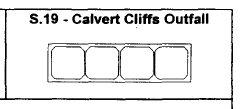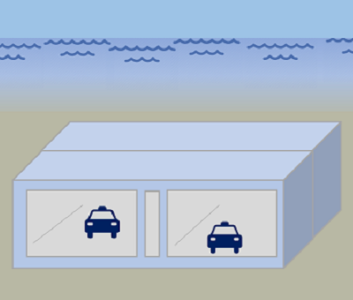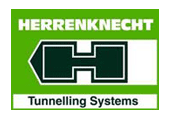Calvert Cliffs Outfall Conduit
HEIGHT: 4.41 m
TOTAL IMMERSED LENGTH: 305 m
WIDTH: 16.76 m
DEPTH AT BOTTOM OF STRUCTURE: 6.6 m
ENVIRONMENTAL CONDITIONS:
Heavy marine traffic throughout tow route. Shallow depth exposure to wave action.
FABRICATION METHOD:
Cast in an excavated basin in Chesapeake, Virginia and
towed 200 km to the site.
TOTAL IMMERSED LENGTH: 305 m
WIDTH: 16.76 m
DEPTH AT BOTTOM OF STRUCTURE: 6.6 m
ENVIRONMENTAL CONDITIONS:
Heavy marine traffic throughout tow route. Shallow depth exposure to wave action.
FABRICATION METHOD:
Cast in an excavated basin in Chesapeake, Virginia and
towed 200 km to the site.
Maryland,
United States

Baltimore Gas & Electric Co.
Tidewater Construction Corporation
Bechtel Associates
61m
305m
6.6m
Project construction
1972-04-30
5
four tubes
4.41m
16.76m
Tunnel was constructed from elements which had three removable bulkheads. The
inboard end bulkheads for each separate tube was divided into four sections which
!were light enough to be hooked onto and dragged by cable. The outboard bulkhead on
each tube could be hoisted away as a single piece. The elements were floated into
position and ballasted internally to a negative buoyancy of 100 tons. These were then
lowered to the previously dredged and screeded bottom and two jacks were used to
tighten the new element against the previous one with a simple dumbbell gasket in
between. The new element was then flooded and divers progressively removed the
i outboard bulkhead, the middle bulkhead, and finally the four pieces of the inboard
bulkhead. Model tests of the handling characteristics of the element were undertaken
at the U. S. Corps of Engineers laboratory in Vicksburg, Mississippi. These tests indicated
that wave action caused a significant increase on the loading of the lowering
falls during placement.
inboard end bulkheads for each separate tube was divided into four sections which
!were light enough to be hooked onto and dragged by cable. The outboard bulkhead on
each tube could be hoisted away as a single piece. The elements were floated into
position and ballasted internally to a negative buoyancy of 100 tons. These were then
lowered to the previously dredged and screeded bottom and two jacks were used to
tighten the new element against the previous one with a simple dumbbell gasket in
between. The new element was then flooded and divers progressively removed the
i outboard bulkhead, the middle bulkhead, and finally the four pieces of the inboard
bulkhead. Model tests of the handling characteristics of the element were undertaken
at the U. S. Corps of Engineers laboratory in Vicksburg, Mississippi. These tests indicated
that wave action caused a significant increase on the loading of the lowering
falls during placement.
Cast in an excavated basin in Chesapeake, Virginia and
towed 200 km to the site.
towed 200 km to the site.
In casting basin.
Heavy marine traffic throughout tow route. Shallow depth exposure to wave action.
Temporary guide beams. Water ballast to 100 ton negative buoyancy. Sections were
jacked together. Element was then completely flooded and bulkheads were removed
by divers as described above.
jacked together. Element was then completely flooded and bulkheads were removed
by divers as described above.
:Dumbbell shaped neoprene
gasket. Compressed by jacking
only. Ultimate watertightness
not critical because of nature of
tunnel.
gasket. Compressed by jacking
only. Ultimate watertightness
not critical because of nature of
tunnel.
Not applicable.
Screeded bed using temporary pile supported frame.
There was no protective cover over the top of the element. The element was not
placed in a trench but just sat on the screeded bed.
placed in a trench but just sat on the screeded bed.














